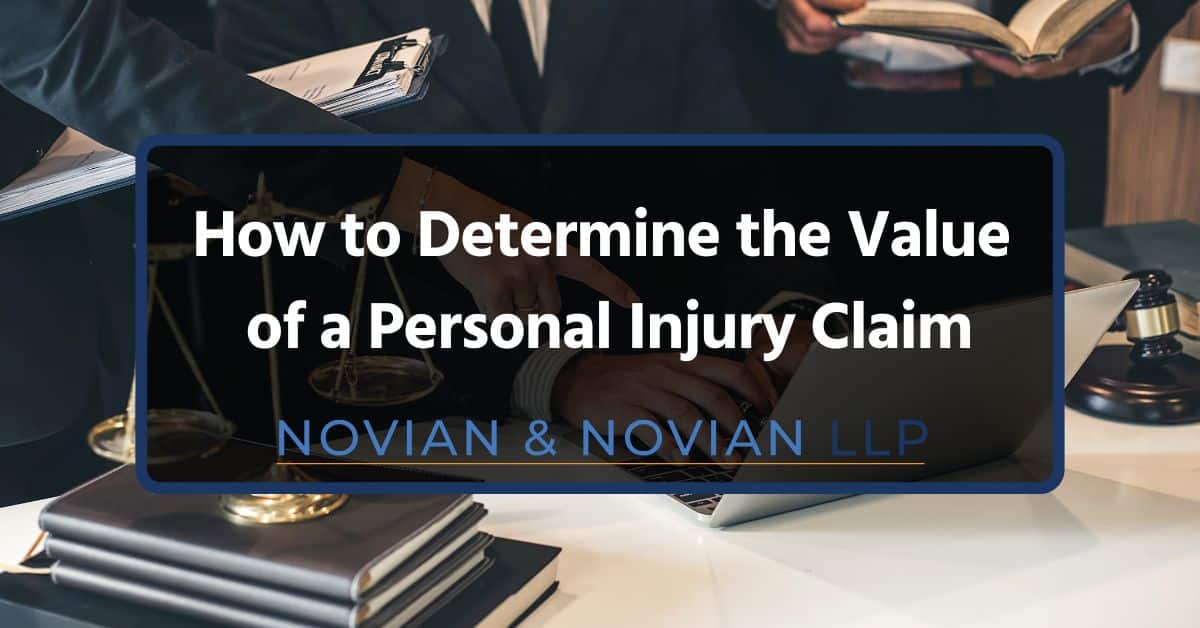A personal injury claim is a legal demand for compensation after you’ve been hurt due to someone else’s negligence or wrongdoing. Now, you may be curious to know how to determine the value of a personal injury claim. The value of a personal injury claim is typically determined by the severity of the injury, financial losses (economic damages), emotional/psychological impact (non-economic damages), and punitive damages.
At Novian & Novian, our catastrophic injury lawyers have over 35 years of experience in helping personal injury victims fight for full compensation. If you’ve suffered a catastrophic injury, you should not settle for less than you’re owed. Contact us now for a free consultation!
This post will give you a detailed breakdown of the key factors that influence the value of a personal injury claim. It will also help you learn how to negotiate your personal injury claim.
What Factors Influence How to Determine the Value of a Personal Injury Claim?
Determining the value of a personal injury claim is not a straightforward calculation. It’s a careful evaluation of many factors that come together to tell the full story of how the injury has affected your life. Below are some key elements that consistently shape how much you may receive in a settlement:
How Severe Is the Injury?
The severity of your injury is one of the most important factors when calculating the value of your claim. Minor injuries like bruises or soft tissue sprains usually result in lower compensation than more moderate injuries such as fractures, concussions, or torn ligaments. However, when it comes to catastrophic injuries that result in long-term or permanent disability, such as spinal cord damage, brain trauma, or amputations, the compensation amount can increase dramatically due to the life-altering impact.
Catastrophic injuries often require lifelong medical treatment and dramatically affect your ability to work, care for yourself, or enjoy daily activities. The long-term prognosis and how much the injury disrupts your quality of life play a major role in the final settlement amount.
What Are Your Medical Expenses?
Medical expenses are the core component of most personal injury claims. These costs are part of your economic damages, which are calculated based on actual expenses you’ve already incurred and those you’re expected to face in the future.
Future medical care and rehabilitation costs must also be accounted for, especially in serious injury cases where ongoing treatment, in-home care, assistive devices, or even future surgeries will be needed. The more comprehensive your medical documentation is, the more accurately your personal injury lawyer can determine the total value of your claim.
How Much Income Have You Lost?
Lost income is another major element when valuing an injury claim. If you’ve had to miss work, even if it’s for a few days or several months, that time off can translate to real financial stress. Your settlement should reflect all wages or income you’ve lost because of your injury.
Even more significantly, if the accident has caused long-term or permanent disability that affects your ability to work or earn as you once did, this loss of future earning capacity must be factored in. This is especially relevant in cases involving catastrophic injuries where the victim can no longer perform their job or has to take on lower-paying work. Your experienced personal injury attorney will help calculate the total economic loss associated with lost wages and long-term income reduction.
What Is the Value of Pain and Suffering?
Not all damages come with a receipt. Pain and suffering represent your non-economic damages. These damages recognize that an accident doesn’t just affect your finances; it changes your life.
Chronic pain, sleepless nights, post-traumatic stress, depression, and the inability to enjoy hobbies or relationships all factor into this part of your claim. While pain and suffering don’t have a fixed dollar amount, attorneys and insurance companies use formulas such as the multiplier method or per diem approach to assign value to these very real but less tangible losses.
Are There Any Property Damages?
If the accident also resulted in property damage, such as a totaled vehicle in a car accident, those costs are included in your personal injury case. Property damage claims are typically straightforward and are based on the fair market value of what was damaged or destroyed. Still, it’s important that all these losses are properly documented and submitted as part of the total value of your claim
Are You Partially at Fault?
Sometimes, an accident isn’t 100% someone else’s fault. If you share any responsibility for the accident, your compensation may be reduced based on the rules of comparative negligence in your state.
For instance, if you are found to be 20% at fault for the accident, your total settlement may be reduced by 20%. It is important to understand how shared fault works, as it is key to knowing what to expect in your final compensation offer.
How Do Insurance Companies Calculate Claim Value?
Insurance companies often use algorithms and claims software to assess injury claims. These programs input data from medical records, accident reports, and other documentation to assign a value. While software may streamline the process, it often undervalues non-economic damages like pain and suffering or emotional trauma.
Two common approaches are the multiplier method, where medical expenses are multiplied by a number (typically 1.5 to 5) based on injury severity, and the per diem method, which assigns a daily rate for pain and suffering. However, insurance companies are also limited by policy limits, which may cap the maximum payout.
Typically, adjusters will also evaluate your credibility, consistency, and documentation quality. That’s why it’s important to have a legal team that understands not just how to present your injury case effectively but how to negotiate with insurance companies and push back when the settlement offer is too low.
If you’re curious to calculate your own settlement, try our calculator:
Personal Injury Calculator

Should You Hire a Personal Injury Lawyer?
After an accident, many people wonder if it is worth it to hire a personal injury lawyer. Yes, hiring an experienced personal injury attorney can make a world of difference in navigating your claims.
One of the biggest benefits of hiring a personal injury lawyer is legal expertise. Personal injury law is complex, and every case involves countless variables like liability, evidence, damages, insurance limits, deadlines, and more. An attorney knows how to evaluate your case, gather and preserve critical evidence, and build a compelling injury claim that highlights the full impact of your losses. This includes both economic damages (like medical bills and lost income) and non-economic damages (like pain and suffering or emotional distress).
Another major advantage is negotiation power. Insurance companies don’t work for you. Instead, they work to protect their bottom line. Without legal representation, you’re far more likely to accept a settlement offer that falls short of the true value of your claim. A personal injury lawyer levels the playing field, negotiating directly with the insurer and pushing back on lowball offers. And if negotiations break down, they’ll be ready to take your case to trial and fight for the full compensation you deserve.
There’s also the peace of mind factor. Instead of juggling phone calls, forms, and confusing legal terms, you can focus on your recovery while your attorney handles the legal heavy lifting. Many personal injury attorneys work under a contingency fee basis, which means you don’t pay anything unless you win your case.
How to Calculate Economic Damages in Your Claim
When pursuing a personal injury claim, one of the first steps is determining the full scope of your economic damages. These are the tangible, out-of-pocket expenses that you’ve incurred as a direct result of your injury. They’re generally easier to calculate than non-economic damages, but they still require clear documentation and careful analysis.
Economic damages typically include medical expenses, such as hospital stays, surgeries, prescriptions, follow-up appointments, physical therapy, and any assistive devices you’ve needed. In many personal injury cases, especially those involving serious or catastrophic injuries, these medical bills can total thousands or even hundreds of thousands of dollars. But the calculation doesn’t end with what you’ve already paid. You should also factor in future medical costs, especially if your condition will require ongoing treatment, rehabilitation, or long-term care.
In addition to medical costs, lost wages form another key part of your economic damages. If your injury forced you to miss work, you’re entitled to claim that lost income. If your ability to work or earn has been permanently affected, your claim should also include compensation for loss of future earning capacity. This often requires input from medical professionals, vocational experts, or financial planners who can project how much you would have earned had the injury not occurred. Property damage is another component. If your personal property was damaged or destroyed in the incident, those costs can be added to the total economic damages.
To accurately quantify these losses, thorough documentation is important. Keep receipts, bills, pay stubs, repair invoices, and insurance reports. For more complex losses, such as long-term disability or future medical care, expert testimony may be necessary to validate your projected damages. The more evidence you have, the stronger and more accurate your personal injury claim becomes.
How Do You Estimate Non-Economic Damages?
Unlike economic damages, non-economic damages don’t come with a paper trail. They represent the intangible losses you’ve suffered after an accident like pain and suffering, emotional distress, anxiety, loss of companionship, and loss of enjoyment of life. These damages can be just as impactful, especially in catastrophic injury cases, but calculating them is more subjective.
Courts and insurance companies use several methods to estimate non-economic damages, and one of the most common is the multiplier method. In this approach, your total economic damages are multiplied by a number, usually between 1.5 and 5, based on the severity of your injury. For example, if your economic damages, such as medical expenses and lost wages, total $100,000 and your injury is considered serious, the multiplier might be 3, resulting in $300,000 in non-economic damages.
Another method is the per diem approach, which assigns a daily rate for your pain and suffering. For example, $150 per day, multiplied by the number of days you’ve been affected. If your recovery took 200 days, the total non-economic damages would be $30,000.
While these formulas offer structure, there are still significant challenges in valuing non-economic damages. Pain and suffering don’t affect every person the same way. Emotional distress from a broken leg may be very different for a professional dancer than it is for someone with a desk job. Insurance companies may also undervalue these damages, especially if you’re not represented by a personal injury lawyer skilled in persuasive argumentation.
To make your case stronger, it’s important to provide personal narratives, medical records, therapy notes, and even testimony from family members to show how your injury has affected your everyday life. An experienced attorney can help present this evidence in a compelling way, ensuring that these very real, very personal losses are fully accounted for in your claim.
How to Negotiate Your Personal Injury Claim
Negotiating a personal injury settlement is about making sure you’re fully compensated for everything you’ve lost. From medical expenses and lost income to pain, emotional trauma, and future care needs, your claim should reflect the true cost of your injury. However, insurance companies are in the business of minimizing payouts, and they’ll often offer far less than your claim is worth.
Here’s how to approach negotiations effectively and clearly:
- Involve a personal injury attorney: Hiring an experienced personal injury lawyer ensures you maximize your potential compensation. Attorneys know how to handle insurance companies, build strong arguments, and negotiate for maximum compensation.
- Gather solid evidence: Strengthen your personal injury claim by collecting medical records, accident reports, witness statements, receipts, and photographs. Strong documentation helps prove the full extent of your economic and non-economic damages.
- Wait until you reach maximum medical improvement (MMI): Don’t rush into a settlement. Wait until you’ve reached MMI so you understand the total medical expenses, future care needs, and how the injury may impact your long-term health and earning capacity.
- Start with a detailed demand letter: Your demand letter should include a full breakdown of your damages (medical bills, lost wages, property damage, pain and suffering), supported by evidence and a clear explanation of why the amount requested is fair.
- Don’t accept the first offer: Initial settlement offers are almost always too low. Counter with a well-supported response that outlines the strength of your case and why the offer doesn’t cover your total losses.
- Stay calm and professional: Keep communication factual and focused. Avoid emotional responses and maintain a polite but firm tone during negotiations. Insurance adjusters are more likely to take you seriously when you present yourself as credible and composed.
- Use negotiation strategies: Consider using the “anchoring technique”. For this, you start with a high but reasonable figure to set the tone and leave room for compromise. This creates space to negotiate further without going below your minimum acceptable amount.
- Highlight the strength of your case: Emphasize key evidence, such as clear liability, strong medical documentation, consistent treatment history, and any expert testimony that supports your claim.
- Be ready to justify your demands: If the insurer pushes back, be prepared with documentation and clear reasoning. Show how each part of your demand is rooted in fact, not emotion.
Want to Get the Most Out of Your Personal Injury Claim?
In this blog, we’ve covered the essential factors that influence how to determine the value of a personal injury claim. These include the severity of your injury, the cost of your medical bills, lost wages, property damage, and the pain and suffering you’ve endured.
We’ve also looked at how both economic and non-economic damages are calculated, and why strong evidence, proper timing, and smart negotiation strategies matter. And most importantly, we’ve shown how working with a skilled personal injury attorney can dramatically improve your chances of receiving fair and full compensation.
The truth is, no two personal injury cases are alike, and trying to handle everything on your own can be risky, especially when insurance companies are working hard to minimize your compensation. The smartest move you can make is to partner with an experienced legal team that knows how to fight for everything you’re owed.
That’s where Novian & Novian comes in. We are known as one of the best personal injury law firms in California, and we’ve helped countless accident victims recover what they’re rightfully owed. Our attorneys understand the law, the tactics insurers use, and how to build powerful injury claims that get results.
Ready to take the next step? Contact Novian & Novian for a free consultation now!
FAQs
If you’re filing a personal injury claim, chances are you’ve got more than a few questions. Below are answers to some of the most common questions injury victims ask when trying to understand their rights, options, and the value of their claim.
What Is the Average Payout for Personal Injury?
There’s no one-size-fits-all answer, but personal injury settlements can range from a few thousand dollars for minor injuries to several hundred thousand or even millions for severe or catastrophic injuries. The value depends on factors like medical expenses, lost wages, pain and suffering, and whether the injury has caused permanent disability.
How Long Does It Take to Settle a Personal Injury Claim?
The timeline varies depending on the complexity of your case. A simple claim may settle in a few months, while a more serious or disputed case could take a year or longer.
Is There a Minimum or Maximum Value for a Personal Injury Claim?
There’s no legal minimum or maximum value set for personal injury claims. Instead, the amount you receive is determined by the specific damages you’ve suffered, both economic and non-economic. However, the at-fault party’s insurance policy limits can cap how much compensation is available, which is why working with a knowledgeable lawyer is critical for identifying all potential sources of recovery.
What if the Insurance Company Denies My Claim Entirely?
If your claim is denied, don’t panic and definitely don’t give up. Insurance companies deny claims for many reasons, some valid and some not. A personal injury lawyer can appeal the denial, negotiate with the insurer, or take the case to court if necessary. You still have rights, and denial doesn’t always mean the end of the road.
Is Compensation From a Personal Injury Claim Taxable?
In most cases, compensation from a personal injury settlement is not taxable, especially when it’s awarded for physical injuries, medical bills, or pain and suffering. However, there are exceptions. For example, any portion of the settlement related to lost wages may be subject to income tax, and punitive damages are often taxed. It’s always smart to speak with a tax professional or attorney to understand how your specific compensation might be treated under IRS rules.





